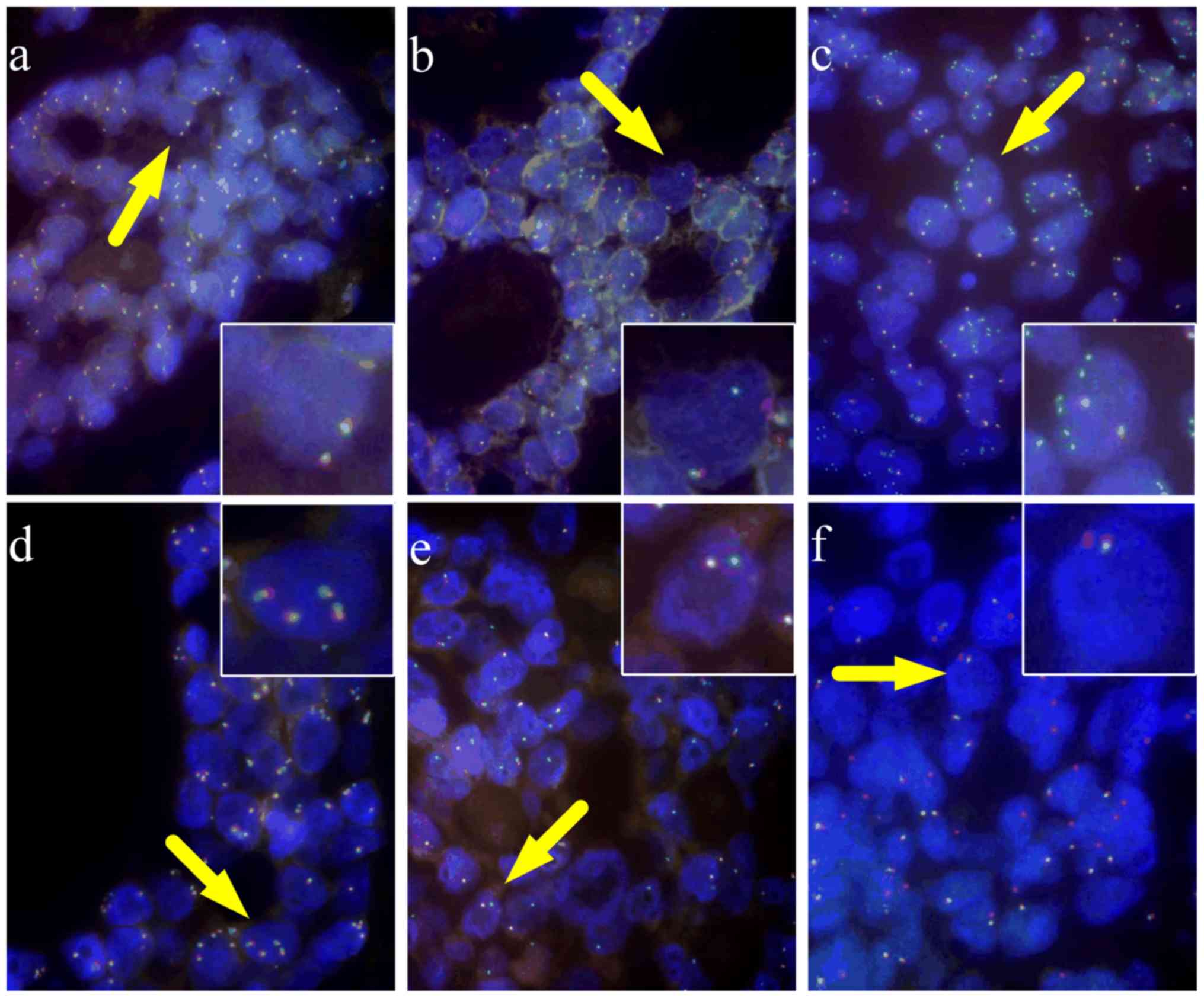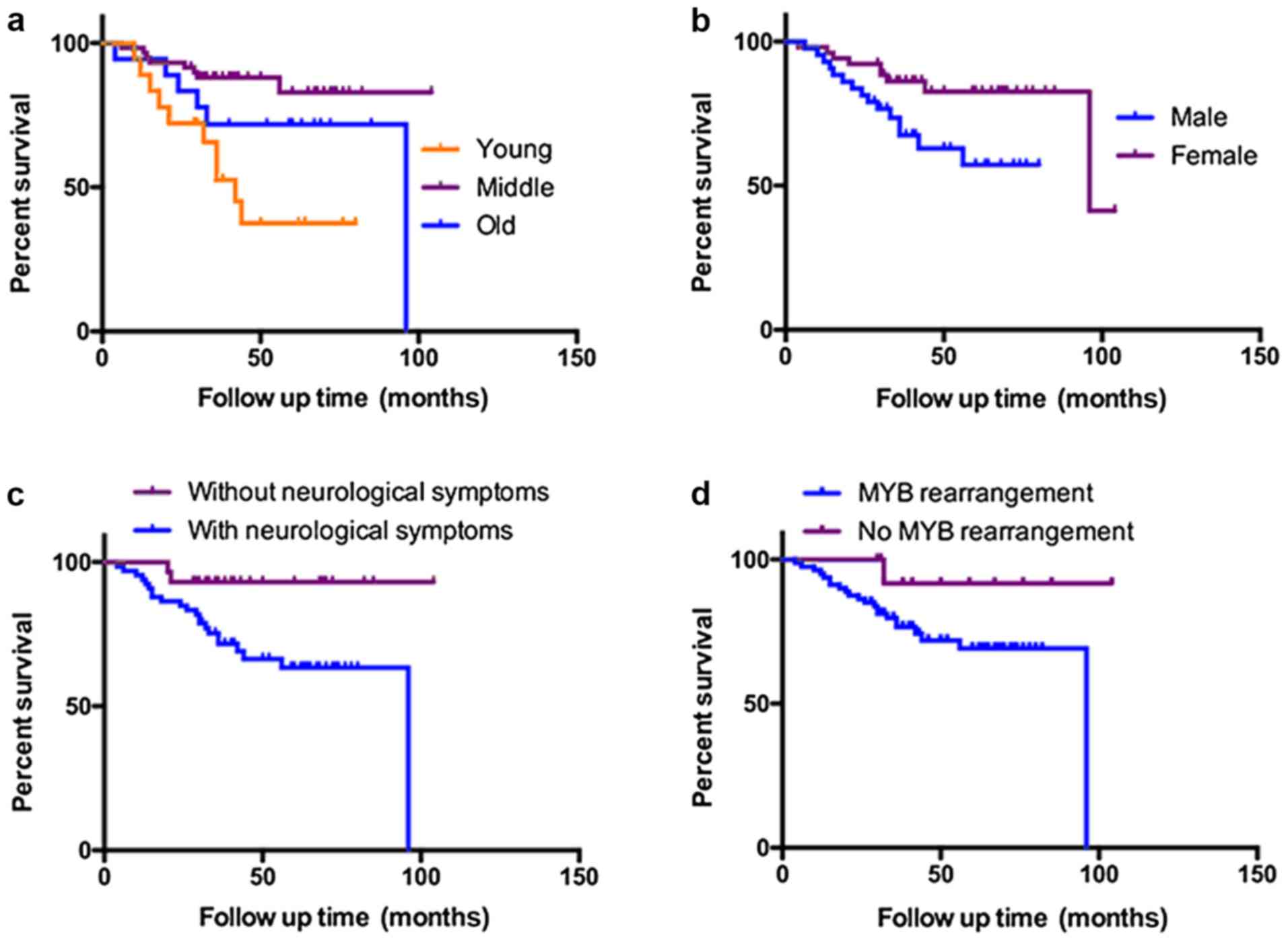|
1
|
Coca-Pelaz A, Rodrigo JP, Bradley PJ,
Vander Poorten V, Triantafyllou A, Hunt JL, Strojan P, Rinaldo A,
Haigentz M Jr, Takes RP, et al: Adenoid cystic carcinoma of the
head and neck--An update. Oral Oncol. 51:652–661. 2015. View Article : Google Scholar : PubMed/NCBI
|
|
2
|
Broz M, Steiner P, Salzman R, Hauer L and
Starek I: The incidence of MYB gene breaks in adenoid cystic
carcinoma of the salivary glands and its prognostic significance.
Biomed Pap Med Fac Univ Palacky Olomouc Czech Repub. 160:417–22.
2016. View Article : Google Scholar : PubMed/NCBI
|
|
3
|
Fordice J, Kershaw C, El-Naggar A and
Goepfert H: Adenoid cystic carcinoma of the head and neck:
Predictors of morbidity and mortality. Arch Otolaryngol Head Neck
Surg. 125:149–52. 1999. View Article : Google Scholar : PubMed/NCBI
|
|
4
|
Spiro RH: Distant metastasis in adenoid
cystic carcinoma of salivary origin. Am J Surg. 174:495–498. 1997.
View Article : Google Scholar : PubMed/NCBI
|
|
5
|
Zhang CY, Xia RH, Han J, Wang BS, Tian WD,
Zhong LP, Tian Z, Wang LZ, Hu YH and Li J: Adenoid cystic carcinoma
of the head and neck: Clinicopathologic analysis of 218 cases in a
Chinese population. Oral Surg Oral Med Oral Pathol Oral Radiol.
115:368–375. 2013. View Article : Google Scholar : PubMed/NCBI
|
|
6
|
Brierley JD, Gospodarowicz MK and
Wittekind C: TNM classification of malignant tumours (8th edition).
(Chichester, West Sussex, UK). Wiley-Blackwell. ISBN
978-1-4443-3241-4. 2017.
|
|
7
|
Khafif A, Anavi Y, Haviv J, Fienmesser R,
Calderon S and Marshak G: Adenoid cystic carcinoma of the salivary
glands: A 20-year review with long-term follow-up. Ear Nose Throat
J. 84:662–664, 667. 2005.PubMed/NCBI
|
|
8
|
Dodd RL and Slevin NJ: Salivary gland
adenoid cystic carcinoma: A review of chemotherapy and molecular
therapies. Oral Oncol. 42:759–769. 2006. View Article : Google Scholar : PubMed/NCBI
|
|
9
|
Ciccolallo L, Licitra L, Cantú G and Gatta
G; EUROCARE Working Group, : Survival from salivary glands adenoid
cystic carcinoma in European populations. Oral Oncol. 45:669–674.
2009. View Article : Google Scholar : PubMed/NCBI
|
|
10
|
Bhayani MK, Yener M, El-Naggar A, Garden
A, Hanna EY, Weber RS and Kupferman ME: Prognosis and risk factors
for early-stage adenoid cystic carcinoma of the major salivary
glands. Cancer. 118:2872–2878. 2012. View Article : Google Scholar : PubMed/NCBI
|
|
11
|
Stenman G: Fusion oncogenes in salivary
gland tumors: Molecular and clinical consequences. Head Neck
Pathol. 7 Suppl 1:S12–S19. 2013. View Article : Google Scholar : PubMed/NCBI
|
|
12
|
Persson M, Andrén Y, Mark J, Horlings HM,
Persson F and Stenman G: Recurrent fusion of MYB and NFIB
transcription factor genes in carcinomas of the breast and head and
neck. Proc Natl Acad Sci USA. 106:18740–18744. 2009. View Article : Google Scholar : PubMed/NCBI
|
|
13
|
Pusztaszeri MP, Sadow PM, Ushiku A,
Bordignon P, McKee TA and Faquin WC: MYB immunostaining is a useful
ancillary test for distinguishing adenoid cystic carcinoma from
pleomorphic adenoma in fine-needle aspiration biopsy specimens.
Cancer Cytopathol. 122:257–265. 2014. View Article : Google Scholar : PubMed/NCBI
|
|
14
|
Tian Z, Li L, Zhang CY, Gu T and Li J:
Differences in MYB expression and gene abnormalities further
confirm that salivary cribriform basal cell tumors and adenoid
cystic carcinoma are two distinct tumor entities. J Oral Pathol
Med. 45:698–703. 2016. View Article : Google Scholar : PubMed/NCBI
|
|
15
|
Hudson JB and Collins BT: MYB gene
abnormalities t(6;9) in adenoid cystic carcinoma fine-needle
aspiration biopsy using fluorescence in situ hybridization. Arch
Pathol Lab Med. 138:403–409. 2014. View Article : Google Scholar : PubMed/NCBI
|
|
16
|
West RB, Kong C, Clarke N, Gilks T,
Lipsick JS, Cao H, Kwok S, Montgomery KD, Varma S and Le QT: MYB
expression and translocation in adenoid cystic carcinomas and other
salivary gland tumors with clinicopathologic correlation. Am J Surg
Pathol. 35:92–99. 2011. View Article : Google Scholar : PubMed/NCBI
|
|
17
|
von Holstein SL, Fehr A, Persson M,
Therkildsen MH, Prause JU, Heegaard S and Stenman G: Adenoid cystic
carcinoma of the lacrimal gland: MYB gene activation, genomic
imbalances, and clinical characteristics. Ophthalmology.
120:2130–2138. 2013. View Article : Google Scholar : PubMed/NCBI
|
|
18
|
D'Alfonso TM, Mosquera JM, MacDonald TY,
Padilla J, Liu YF, Rubin MA and Shin SJ: MYB-NFIB gene fusion in
adenoid cystic carcinoma of the breast with special focus paid to
the solid variant with basaloid features. Hum Pathol. 45:2270–2280.
2014. View Article : Google Scholar : PubMed/NCBI
|
|
19
|
Rettig EM, Tan M, Ling S, Yonescu R,
Bishop JA, Fakhry C and Ha PK: MYB rearrangement and
clinicopathologic characteristics in head and neck adenoid cystic
carcinoma. Laryngoscope. 125:E292–E299. 2015. View Article : Google Scholar : PubMed/NCBI
|
|
20
|
Roden AC, Greipp PT, Knutson DL,
Kloft-Nelson SM, Jenkins SM, Marks RS, Aubry MC and García JJ:
Histopathologic and cytogenetic features of pulmonary adenoid
cystic carcinoma. J Thorac Oncol. 10:1570–1575. 2015. View Article : Google Scholar : PubMed/NCBI
|
|
21
|
Chen TY, Keeney MG, Chintakuntlawar AV,
Knutson DL, Kloft-Nelson S, Greipp PT, Garrity JA, Salomao DR and
Garcia JJ: Adenoid cystic carcinoma of the lacrimal gland is
frequently characterized by MYB rearrangement. Eye (Lond).
31:720–725. 2017. View Article : Google Scholar : PubMed/NCBI
|
|
22
|
DeAngelis AF, Tsui A, Wiesenfeld D and
Chandu A: Outcomes of patients with adenoid cystic carcinoma of the
minor salivary glands. Int J Oral Maxillofac Surg. 40:710–714.
2011. View Article : Google Scholar : PubMed/NCBI
|
|
23
|
Guzzo M, Locati LD, Prott FJ, Gatta G,
McGurk M and Licitra L: Major and minor salivary gland tumors. Crit
Rev Oncol Hematol. 74:134–148. 2010. View Article : Google Scholar : PubMed/NCBI
|
|
24
|
Min R, Siyi L, Wenjun Y, Ow A, Lizheng W,
Minjun D and Chenping Z: Salivary gland adenoid cystic carcinoma
with cervical lymph node metastasis: A preliminary study of 62
cases. Int J Oral Maxillofac Surg. 41:952–957. 2012. View Article : Google Scholar : PubMed/NCBI
|
|
25
|
Kokemueller H, Eckardt A, Brachvogel P and
Hausamen JE: Adenoid cystic carcinoma of the head and neck--a 20
years experience. Int J Oral Maxillofac Surg. 33:25–31. 2004.
View Article : Google Scholar : PubMed/NCBI
|
|
26
|
Triantafillidou K, Dimitrakopoulos J,
Iordanidis F and Koufogiannis D: Management of adenoid cystic
carcinoma of minor salivary glands. J Oral Maxillofac Surg.
64:1114–1120. 2006. View Article : Google Scholar : PubMed/NCBI
|
|
27
|
Ellington CL, Goodman M, Kono SA, Grist W,
Wadsworth T, Chen AY, Owonikoko T, Ramalingam S, Shin DM, Khuri FR,
et al: Adenoid cystic carcinoma of the head and neck: Incidence and
survival trends based on 1973–2007 Surveillance, Epidemiology, and
End Results data. Cancer. 118:4444–4451. 2012. View Article : Google Scholar : PubMed/NCBI
|
|
28
|
da Cruz Perez DE, de Abreu Alves F, Nobuko
Nishimoto I, de Almeida OP and Kowalski LP: Prognostic factors in
head and neck adenoid cystic carcinoma. Oral Oncol. 42:139–146.
2006. View Article : Google Scholar : PubMed/NCBI
|
|
29
|
Kataoka A, Iwamoto T, Tokunaga E, Tomotaki
A, Kumamaru H, Miyata H, Niikura N, Kawai M, Anan K, Hayashi N, et
al: Young adult breast cancer patients have a poor prognosis
independent of prognostic clinicopathological factors: A study from
the Japanese Breast Cancer Registry. Breast Cancer Res Treat.
160:163–172. 2016. View Article : Google Scholar : PubMed/NCBI
|
|
30
|
Liu S, Feng F, Xu G, Liu Z, Tian Y, Guo M,
Lian X, Cai L, Fan D and Zhang H: Clinicopathological features and
prognosis of gastric cancer in young patients. BMC Cancer.
16:4782016. View Article : Google Scholar : PubMed/NCBI
|
|
31
|
Sgaramella N, Lindell Jonsson E, Boldrup
L, Califano L, Coates PJ, Tartaro G, Lo Muzio L, Fåhraeus R,
Colella G, Dell'Aversana Orabona G, et al: High expression of
podoplanin in squamous cell carcinoma of the tongue occurs
predominantly in patients ≤40 years but does not correlate with
tumour spread. J Pathol Clin Res. 2:3–8. 2015. View Article : Google Scholar : PubMed/NCBI
|
|
32
|
Zhou YE, O'Rourke JP, Edwards JS and Ness
SA: Single molecule analysis of c-myb alternative splicing reveals
novel classifiers for precursor B-ALL. PLoS One. 6:e228802011.
View Article : Google Scholar : PubMed/NCBI
|
|
33
|
Glasspool RM, Brown R, Gore ME, Rustin GJ,
McNeish IA, Wilson RH, Pledge S, Paul J, Mackean M, Hall GD, et al:
A randomised, phase II trial of the DNA-hypomethylating agent
5-aza-2′-deoxycytidine (decitabine) in combination with carboplatin
vs carboplatin alone in patients with recurrent, partially
platinum-sensitive ovarian cancer. Br J Cancer. 110:1923–1929.
2014. View Article : Google Scholar : PubMed/NCBI
|
|
34
|
Barrett AW and Speight PM: Perineural
invasion in adenoid cystic carcinoma of the salivary glands: A
valid prognostic indicator? Oral Oncol. 45:936–940. 2009.
View Article : Google Scholar : PubMed/NCBI
|
|
35
|
Gondivkar SM, Gadbail AR, Chole R and
Parikh RV: Adenoid cystic carcinoma: A rare clinical entity and
literature review. Oral Oncol. 47:231–236. 2011. View Article : Google Scholar : PubMed/NCBI
|
|
36
|
Gomez DR, Hoppe BS, Wolden SL, Zhung JE,
Patel SG, Kraus DH, Shah JP, Ghossein RA and Lee NY: Outcomes and
prognostic variables in adenoid cystic carcinoma of the head and
neck: A recent experience. Int J Radiat Oncol Biol Phys.
70:1365–1372. 2008. View Article : Google Scholar : PubMed/NCBI
|
|
37
|
Mendoza PR, Jakobiec FA and Krane JF:
Immunohistochemical features of lacrimal gland epithelial tumors.
Am J Ophthalmol. 156:1147–1158.e1. 2013. View Article : Google Scholar : PubMed/NCBI
|
|
38
|
Persson M, Andrén Y, Moskaluk CA, Frierson
HF Jr, Cooke SL, Futreal PA, Kling T, Nelander S, Nordkvist A,
Persson F and Stenman G: Clinically significant copy number
alterations and complex rearrangements of MYB and NFIB in head and
neck adenoid cystic carcinoma. Genes Chromosomes Cancer.
51:805–817. 2012. View Article : Google Scholar : PubMed/NCBI
|
















